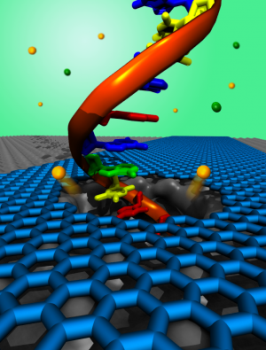Aug 6 2014
Marija Drndić, a professor in the Department of Physics & Astronomy in the University of Pennsylvania's School of Arts & Sciences has been awarded a two-year, $880,000 grant for a project aimed at reducing the cost and time of genome sequencing. The grant was made by the National Human Genome Research Institute of the National Institutes of Health.
 An illustration of single-stranded DNA passing through a nanopore in a graphene nanoribbon. (Credit: Robert Johnson)
An illustration of single-stranded DNA passing through a nanopore in a graphene nanoribbon. (Credit: Robert Johnson)
During the past decade, DNA sequencing costs have fallen dramatically, fueled by tools, technologies and process improvements developed by genomics researchers.
Price, however, together with speed and accuracy, are still hurdles in the widespread use of genomics in research and clinical care. The grants, made through the NHGRI's Advanced DNA Sequencing Technology Program and totaling as much as $14.5 million between eight groups, will attempt to address all of these challenges.
Drndić's approach to gene sequencing involves a process known as DNA translocation through a nanopore. The technique typically involves threading DNA, suspended in an ionic fluid, through a tiny hole in a thin membrane. Each of the four bases of a DNA sequence block different amounts of the aperture as they pass through, thus allowing a different number of ions to pass through along with them. In most nanopore sequencing, researchers attempt to identify bases by reading changes in ion current through the nanopore.
This award will support Drndic’s approach to this process, in which a thin material around the nanopore is proposed to directly sense the bases, potentially enabling an electrical recording of a different signal for each base.
The new grant will specifically support Drndić's proof-of-principle research on translocation through nanopores in graphene nanoribbons. Graphene is a single-atom-thick lattice of carbon and is the most electrically conductive material yet known, offering potential advantages over nanopores made in other materials, including metals or biological molecules. The high conductivity of graphene could eliminate the need for additional amplification of the electrical signal stemming from the nanopore.
“There is a strong demand for fast and cheap DNA sequencing,” Drndić said. “Graphene’s electrical properties mean that we may be able to read out signals from the bases from the graphene nanoribbon as DNA molecules in solution go through the pore, rather than from ionic current. This means that we may not need to slow down the DNA to make an accurate reading. This project will build the fundamental understanding behind processes governing DNA interactions with graphene nanoribbons.”
Drndić’s research is also made possible by Penn’s Krishna P. Singh Center for Nanotechnology, which contains the transmission electron microscopes and cleanroom facilities necessary to work with graphene nanoribbons.